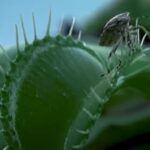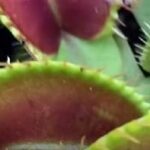As an Amazon Associate, this site earns commissions from qualifying purchases. For more details, click here.
Is your Venus flytrap no longer as active as it used to be? Maybe you noticed that its traps are always open now, or maybe you put a bug there but it refuses to close. Is this a cause for alarm? If you want your Venus flytrap to live long, knowing its habits and trap behavior are a must.
Venus flytraps will not close if the prey is too large. Other possible reasons traps will not close are dormancy, lack of sunlight, the wrong soil or a bacterial infection.
Prey is Too Big for the Trap
A healthy Venus flytrap can produce 1-1.5 inch long traps. The largest variant, the B52 has 2 inch traps. This is just the right size for crickets, spiders, fruit flies and other small bugs. If they crawl in the trap no question it will clamp down. Venus flytraps will only close its trap if the prey is small enough. If the prey is too big, the trap will either stay open or be half closed.
But adult cockroaches and moths are too large. These and other bugs can chew their way out of the trap. Even if the insects do not they are just too big for the trap to even close.
There are two things to keep in mind: Venus flytraps will only eat prey if the trap is completely shut. If the leaves cannot close, the plant will eventually release it. So if you see a trap half closed over a cockroach, expect the plant to release it eventually.
New Venus flytrap owners tend to worry about not giving the plant enough insect food. In reality the traps only need very little. The ideal is 3-5 bugs a month, though feeding one bug a month is fine too.
It is more dangerous to overfeed the plant, as the trap could literally kill itself trying to digest a large bug. If the trap is unable to close, it will eventually let the bug go. If that happens, you can slice the bug into smaller bits and then give it again.
Improper Feeding
Venus flytraps eat dead bugs, so why does the trap not close when you drop that spider? Well you have to give the plant a hand.
Venus flytraps will only shut if the trap hairs are triggered. Dead bugs cannot provide stimulation so you have to tap the hairs to get the trap to close. This rule applies to freeze dried food too.
When an insect lands in one of the traps, it will not immediately shut. The insect must make contact with the hair trigger sensors twice in a 20-30 second span.
If you drop a dead fly in the trap, nothing will happen. The trap will not close because it is not able to stimulate the hairs.
What you need to do is tap the hairs twice after dropping the bug. This alerts the plant of the presence of prey and it will initiate the digestive process. Do not worry, Venus flytraps cannot hurt you.
The benefit of giving dead bugs to Venus flytraps is you can control how much the trap eats. By cutting a bug in two (or three) you make certain it is small enough to fit in the trap.
Venus flytraps outside do not need to be fed dead bugs.. There is more than enough insects around. Indoor Venus flytraps should be fed though since they do not have access to those insects.
Poor Health
Fungal or bacterial infection weakens Venus flytraps and may even be fatal. While traps that refuse to close is one of the symptoms, you have to examine the plant thoroughly.
You have to check for other possible reasons why your Venus flytrap may refuse to shut. If you have exhausted all the possibilities, look for other signs of poor health:
- Several leaves turn black
- Bad smell coming from the plant or soil
- Colors are dull or pale
- The plant looks withered
You should also check if there is root rot. Remove the plant from its pot. If the roots and rhizome are slimy, root rot, bacterial or fungal infection has set in. Cut off the infected parts and repot the healthy parts left.
Venus flytraps can deteriorate rapidly if infection is left untreated. Always keep an eye on its health and any warning signs. Again though, traps that refuse to shut is only one possible symptom, and you have to look for other signs.
Wrong Soil and Water
Venus flytraps are very particular about soil and water. Using the wrong type will be detrimental for the plant.
Use only nutrition free soil mix like peat moss and perlite. Rich soil is harmful to the plant and weaken its immune system. This can affect the traps’ ability to function properly.
We recommend purified distilled water. Keep the soil moist all the time and never let it dry out. The mineral deposits in tap water might cause serious damage to the leaves.
Do not overwater your Venus flytrap. If you are not sure how much to use, place your Venus flytrap in a 4-6inch pot with draining holes. Now put that pot in a tray with an inch of water. All you need to do now is refill the tray when it dissipates.
Poor Environment
Venus flytraps like a warm environment, so cold weather affects them badly. When a trap digests prey, it uses a lot of energy, and in a cold environment that can stress the plant.
The key here is to make sure your Venus flytraps receive warmth and sunlight. Ideally the plant should get 12 hours of sunlight. You can also use artificial lights provided you keep it on for 12 to 16 hours a day.
Venus flytraps can withstand temperatures up to 104 F (40 C), but ideally it should be around 87-95 F (31-35 C). Heat is important, but sunlight is even more so because Venus flytraps need it for photosynthesis.
Photosynthesis allows the plant to produce glucose. Glucose fuels the plant and allows it to use insect nutrients to grow traps. Without sufficient glucose, the plant will not have enough energy to keep traps functioning.
Trap is Dying
Venus flytraps can live up to 20 years or longer, but each trap has a short lifespan. On average these leaves can shut five times. After that it will get discarded.
If one of the traps is dying of old age, then it may no longer be able to close. There is nothing wrong with the plant, the trap just reached the end of its life cycle. You can wait for the plant to drop the dead leaves or you can trim it yourself.
If the Venus flytrap is healthy, the dead trap will be replaced by a new one. Some of these plants can produce up to 20 traps at a time, though 5-10 is the most common.
Dormancy
Venus flytraps enter dormancy in winter. During this period, its traps may stop closing and the plant itself could shrink and look withered. Dormancy typically starts in November and ends in March.
If you notice its traps seem lifeless during this period, it is normal. The plant will discard most of its leaves and look really sick. But this is nothing to worry about. Water the plant every month or so, but do not give it any food.
Dormant Venus flytraps prefer a temperature of 30-35 F (1-2 C). You do not need to provide lighting, natural or otherwise. Lower temperatures are acceptable but the plant will discard even more traps. When spring arrives, the plant will slowly come back to life.
Conclusion
Hopefully this guide was able to clear up some facts and shed light on some misconceptions. As someone who grows Venus flytraps, you should learn as much as you can about its feeding habits so if a trap does not close, you will have an idea why and what to do.

My fascination with carnivorous plants began many, many years ago with Venus Fly Traps. Now I am more than happy to impart what I know with other enthusiasts and those who are curious about meat eating plants.



